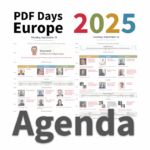PDF/X: Tools and usage

Andrew graduated from what is now the University of Arts London and went on to serve an apprenticeship as a Compositor. He has worked for a number of vendors in the printing and publishing sector, including Scangraphic, Apple, and DuPont/Crosfield. He has been Prepress Manager for several high-quality printing companies … Read more


by Andrew Bailes-Collins
PDF/X Tools
The good news for anybody wishing to start working with PDF/X standards, is that there are many tools available to support all aspects of PDF/X production. The current PDF/X specifications are well established and mature as far as software developers are concerned.
PDF/X Creation
PDF/X files can be created directly from professional page layout packages such as Adobe InDesign or Quark Xpress. When exporting to PDF, the user can simply select the required PDF/X version (1, 3, or 4) and the software will guide the user, allowing only configuration settings that will produce a valid PDF/X file.
It is not possible to directly export a valid PDF/X file using the output options within office applications such as Microsoft Word or OpenOffice. However, it is possible to export a PDF file that can then be converted to PDF/X using an additional application capable of correcting the file to meet one of the PDF/X standards. These solutions can be desktop or server-based, depending on the volume of files that need to be processed. These solutions generally begin by checking PDF/X conformance, and subsequent correction to PDF/X is part of this process.
PDF/X Conformance and Correction
Quality control and PDF/X conformance are a key part of the production process. It doesn’t matter if you are supplying files to a print service provider, or processing PDF files within a print company; quality control is paramount. Failure to ensure that a PDF file meets the required standard can result in missed deadlines, wasted time, material and extra cost. The later a problem with a PDF file is detected, the more expensive that problem is to fix.
The graphic arts industry uses a specific term for this quality control process: preflight. The term was inherited from the preflight checks that a pilot carries out before taking off in an aircraft. In a similar process, a print service provider will thoroughly check a PDF file before it enters the production process to ensure it is of sufficient quality for the required printed product.
Most PDF preflight solutions offer the opportunity for a Print Service Provider (PSP) to correct a lot of the issues that can arise within PDF files. This can be done as part of the service the PSP provides to its customer, or can be chargeable. In newspaper or magazine production, it is not uncommon for publications to insist on a ‘print ready’ PDF/X file. These publications are not willing to take the responsibility for any potential issues that may arise if they correct the file themselves.
PDF/X preflight and correction solutions are available in several different types of application.
Desktop solutions
For users who have a relatively low number of files to process, a manual .application will probably be the most appropriate.
Desktop applications such as Adobe Acrobat have built–in preflight capabilities that enable PDF/X conformance to be checked and corrected. There are also third-party plugin applications for Adobe Acrobat that extend those preflight and correction capabilities.
Server-based solutions
For users who must check and correct hundreds or thousands of PDF/X files a day, hot-folder driven and server-based preflight solutions are available. These applications are often also available as Command Line Interface (CLI) software capable of driving the quality control process programmatically. These allow high volume automated production, and can be driven by external systems using database connections or XML job tickets to allow the preflight check to be specific to the customer’s order or advertising booking.
PDF workflow and output
PDF/X conformance and preflight are just two of the prepress production processes that a PDF/X file must go through to be successfully printed, but they are only pieces in a much larger workflow puzzle. When working with PDF/X, it’s important that all pieces and processes in a print production workflow system are configured appropriately to handle the PDF/X version in use; it is not sufficient to just use a PDF/X preflight check. Many workflow vendors provide data sheets explaining how workflows must be configured to handle PDF/X files correctly.
Programming libraries
Programming libraries allow developers to integrate PDF/X functionality into their own applications without having to develop the technology from scratch.
Some desktop or server-based products are also available as programming libraries. With these “Software Development Kits”, companies can add PDF/X functionality with minimal effort, and bring solutions to market very quick.ly. These libraries offer PDF/X creation, preflight and/or correction.




